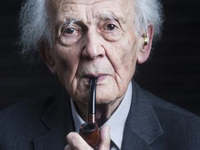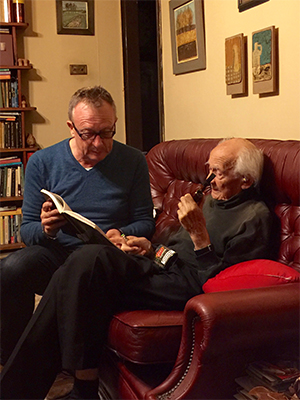Read more about In Memoriam

Zygmunt Bauman, the Skeptical Utopian
by Maciej Gdula

Zygmunt Bauman’s Moral Vision
by Peter McMylor
May 30, 2017
When the Emperor departs, there is often mourning, and some gloating. Is this an interregnum? Was Zygmunt Bauman an emperor? I don’t think so. He was a latecomer to fame, a reluctant celebrity, hopeless at the ten-second grab. Understanding, as he would say, does not come in bite-sized pieces. His was an untidy prominence. He was an insider/outsider.
Bauman’s first book in English, on the British labor movement, appeared in 1972. He was marginalized for this effort by Edward Thompson, and he remained invisible or peripheral for many years. He was ignored by his colleagues, then bagged for self-plagiarism, for a sociology that he allegedly “made up,” analyzing often by metaphor rather than by duly-authorized data bank, and his communist past was questioned; surely he was guilty of something. His epigones wanted him off the stage, out of their sunlight.
Yet Bauman was read and heard around the world by many, many people in many lands, for whom this encounter, in person or on the page, was transformative. Perhaps this is the source of the jealousy. Bauman stepped aside from footnotes and went to the issues. He no longer wrote for colleagues who might read his work serially, but rather wrote for punters, for the commuters of everyday life. His was the data of life, of the experience of the twentieth century and its successors; he urged us to take on the problems of the world as our own, all of us. The job of intellectuals was to ask questions, not to provide answers for those who really owned these problems, whether to do with poverty, forced mobility and suffering, or with love, loss and loyalty.
Perhaps I might tell a story here. For if Bauman was not a storyteller, then he was certainly a conversationalist. For 25 years, I visited Bauman annually in Leeds. The last time I saw him was in 2015, for his ninetieth birthday. I was working at Stellenbosch in South Africa. And there he popped up, in South Africa, like an old mole, before we headed off to Cape Town, flew to Manchester, then to Leeds over the Pennines by train. (I missed his last birthday; we were in Chengdu, where we had been invited to talk about the Baumans, Zygmunt and Janina. The Chinese are also keenly interested in Bauman.)
Before leaving for China, I was working on a paper for Bauman for the Revue Internationale de Philosophie. One of the attractions his work holds is that even after 30 years, I have not yet exhausted his interests. When I borrowed a copy of Legislators and Interpreters (1987) from the Stellenbosch University Library, I discovered to my pleasure that it was heavily annotated, every page. The next text I revisited was Liquid Modernity (2000). Chapter 3 is “Time/Space.” This fell open on the page where Bauman turns to South Africa – in fact, to Somerset West, near where I was living and working. Its subject? Gated housing, elevated to an art form here in South Africa. The project he engages with – the hilariously entitled “Heritage Park” – remains incomplete, located across a great concrete and mesh divide, the N2 freeway, from Lwandle, a black township of significant pride and achievement. Here we are, masters and slaves, tourists and vagabonds; Bauman’s optic extends from Leeds to South Africa.
He frowned, and asked, mischievously (for there was always mischief), had I stolen the book from the library? I said no, I had borrowed it. And there we are, inspecting it together, on the last occasion I would ever share his company at Lawnswood Gardens. A long way from Somerset West, and yet, also, maybe not. Modernity travels with its dark side.
It was my privilege, among others, to be Bauman’s interpreter. As he said, my job was to put order into the chaos of his work. He was a compulsive writer; witness the 58 or so books in English. This is a rich legacy of nimble engagement with the signs of his times, with problems of everyday life which he characterized as “liquid modern.”
So this would be my advice to any newcomer, just pull any topic or thread from Bauman’s texts and see what unravels. Perhaps like Simmel, he was a sociological impressionist, the analyst of life in fragments. But he always followed Marx, so that his interest might be described as one that lies in culture and its relationships, its asymmetrical relations of production and distribution. And then, like Gramsci, he never gave up on the sense that we could do better.
Now that it is over, how might we characterize his work? Across the path of my engagement with Bauman, I have made several attempts to characterize his work: a critique of modernity as excess, a sociology of surplus populations, a theory of alternative modernities, including Nazi Germany, or a sociology of waste. More conventionally, it might be described as a critique of modernity without illusions; an East European critical theory – and the east bit matters here; or a Weberian Marxism. There are many other projects here, including a critique of classificatory reason. More recently, his work might be described as a diagnosis of the times, a critique of the signs of the times, a series of warnings delivered in the spirit of hope.
Was he an example? Absolutely; but he was not a leader. His example was to make it clear that we each need to go our own way. That is the only way to keep alive the hope of critical sociology.
Peter Beilharz, Curtin University, Australia
This issue is not available yet in this language.
Request to be notified when the issue is available in your language.
If you prefer, you can access previous issues available in your language:

















